Speech The Outlook for Business Investment in Australia

Christopher Kent
Assistant Governor (Economic)
Remarks to the Bloomberg Australia Economic Summit 2013
Sydney –
- Audio 12.67MB
Let me start by thanking Bloomberg for the invitation to speak to you at this Summit. Today I'd like to review the outlook for business investment in Australia given the important bearing it has on our forecast for economic activity overall.
Business investment in Australia is higher now as a share of GDP than at any other time over the past 60 years (Graph 1). This reflects two quite different trends. On the one hand, investment in the resources sector has been building consistently from around the mid 2000s, when the prices of Australia's key commodity exports began to rise significantly.
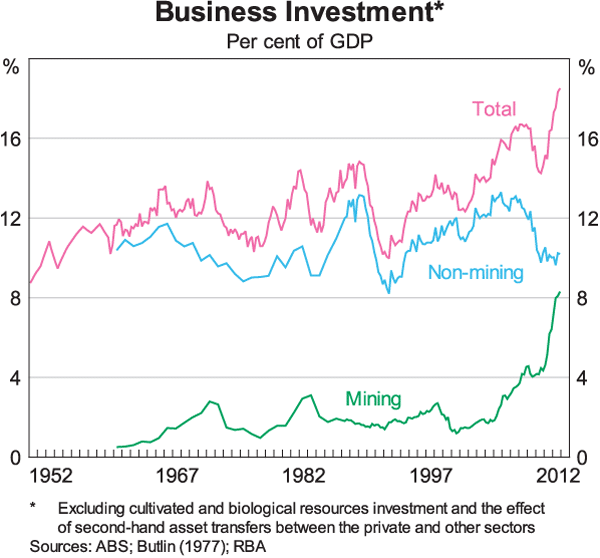
On the other hand, non-mining business investment declined from 2008 to about 2010 in real terms, and has remained relatively low as a share of nominal GDP since then. This outcome reflects a number of different influences, to which I'll return in a minute. I should stress though that the relatively low levels of investment outside of the resources sector (including dwelling investment) has been part of the way in which the Australian economy has adjusted to the unprecedented boom in commodity prices.[1] If this had not been the case, the strength of demand might otherwise have led to a period of higher inflation, and all the problems that come with that. Instead, inflation has remained at, or close to target, and economic growth has been close to trend. This has been a good outcome for the macroeconomy, particularly when compared with previous commodity price booms.
But the peak in resources investment is now close. Once it has passed, the decline in mining investment – and the effect of the still high level of the exchange rate and ongoing fiscal consolidation – will weigh on economic growth. This provides scope for other sources of demand to pick up. Some of that will come in the form of strong growth in resources exports. For bulk commodities, where much of the investment has taken place, exports have already been growing strongly and this is expected to continue (Graph 2). In particular, exports of liquefied natural gas (LNG) are expected to grow very significantly as new production facilities come on line from around 2015. While this welcome boost to exports will help to support growth of GDP, the demand for labour in resource and resource-related activities should wane as the sector moves from the investment to the operational, and less labour intensive, phase of the boom.
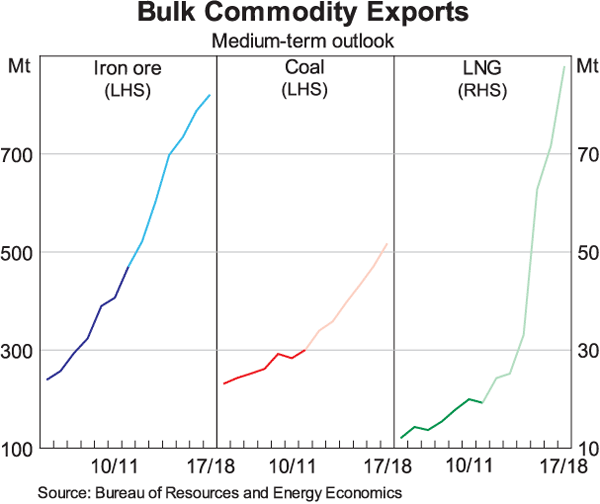
As you all know, there has been a significant easing in monetary policy, starting in late 2011. There are signs that the low level of interest rates is having some of the expected effects and these are likely to have further to run. The effects are clearly evident in the established housing market and, as I have discussed at some length recently, this should help to underpin further moderate growth in dwelling construction.[2]
As for non-mining business investment, we expect that this will also grow moderately in real terms over this year and next.
As always, uncertainty around these forecasts is considerable.[3] Part of this comes from the fact that data is available with a lag and is subject to revision for some time.
These revisions are typically larger for business investment than for many of the other components of expenditure in the national accounts.[4]
With that caveat in mind, I'll turn to a discussion of what's been happening to mining and non-mining investment of late and what the likely outlook is for both.
Mining Investment
Commodity prices fell sharply around the middle of 2012, reaching a low point in September (Graph 3). This had a noticeable effect on the resources sector: some companies scaled back their investment intentions and reduced spending where possible to preserve cash flows. While prices of the bulk commodities are now above the low points reached last year, mining companies indicate that they remain focused on containing costs and that, for some, obtaining finance for new projects remains difficult.
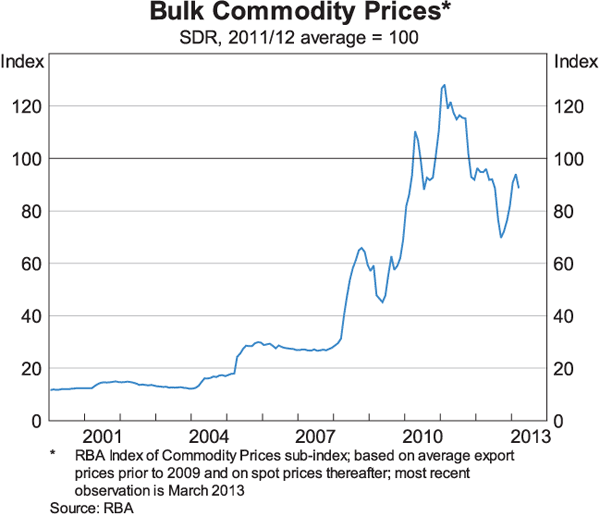
During the years that commodity prices were growing rapidly, there was a tendency for forecasts of mining investment to be revised upwards, as the stock of projects under consideration, and the flow of these into commitments, increased. In contrast, the prospect of sizeable new commitments, though still present, appears much less for the next few years than was the case in the past decade. Instead, the rate of progress on existing projects and any further cost overruns are likely to have a more important bearing on the profile for mining investment in the near term. For some investment projects, most notably in the LNG sector, there have already been delays associated with logistical problems affecting a number of the very large, complex undertakings. Any further delays will reduce investment now but add to it later on. Also, cost overruns, to the extent that they reflect the need for more work than was originally planned, represent extra investment. This is not great from the view point of shareholders in resources companies, but it is investment activity nonetheless.
While the exact timing of the peak in mining investment and the profile thereafter are uncertain, there is still a sizeable amount of work in the pipeline, including a number of large LNG projects. This means that the level of mining investment is likely to remain quite elevated for a time.
Our assessment at the time of the February Statement on Monetary Policy (SMP) was that mining investment was likely to peak at around 8 per cent of GDP sometime this year and stay at a still high level for a bit beyond that time. We are in the process of reviewing the forecasts ahead of the May SMP. At this stage, there has not been a lot of new information relevant to mining investment. Spot prices of iron ore have declined, but this was widely expected and follows a larger-than-expected jump up in prices around the end of 2012. Also, the latest capital expenditure survey by the Australian Bureau of Statistics was released in late February. It suggests that mining investment could actually rise from the current financial year to the next.[5] While this is more optimistic than the outlook implied by companies' public statements and our own liaison, it highlights the fact that the outlook for mining investment remains uncertain.
Non-mining Business Investment
As I've already mentioned, non-mining business investment is currently at relatively low levels as a share of GDP. The high level of the exchange rate associated with the resources boom has been an important mechanism facilitating the reallocation of labour and capital to firms in resource and resource-related industries away from other trade exposed industries.
However, the high exchange rate has not been the only part of the story. Other forces have tended to weigh on non-mining business investment over recent years. The financial crisis caused significant disruption to economic activity globally and increased uncertainty about demand conditions. Also, even before the financial crisis, households had started to increase their rate of saving while the level of household debt and housing prices stabilised and even declined somewhat as a share of income (Graph 4). This followed a long period of declining saving, rising debt and rising housing prices. The transition to this more sustainable behaviour on the part of households led to a period of weakness in non-resources construction, a decline in turnover in the established housing market and slower growth of consumption compared with that seen through much of the 2000s.
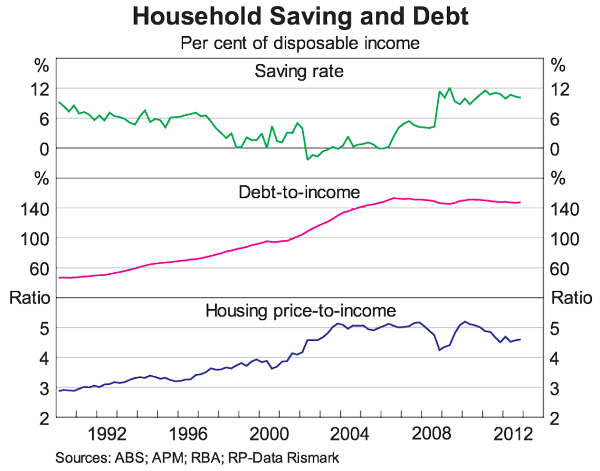
While many of these factors remain in place, they may weigh less heavily on business conditions and hence on business investment in the period ahead. In particular, the low level of interest rates and the rise in asset prices that have underpinned a rise in household net worth are likely to support growth of dwelling investment and consumption by households. There has been a noticeable improvement in conditions in the established housing market and dwelling investment picked up over the second half of 2012, with further moderate growth expected. This should, in time, provide a measure of support to employment and activity in the non-mining business sector. Also, consumer confidence has increased since last year to be above average levels currently. This doesn't mean that consumption growth will return to the very strong pace seen prior to the financial crisis, but it is consistent with consumption growing at least in line with incomes and at a stronger pace than was observed towards the end of last year. Indeed, the stronger retail sales data since the beginning of the year support this outlook. Higher consumption growth will also help to support business activity and investment.
We shouldn't be surprised by the fact that business investment turns up after household spending through the business cycle.[6] This occurs because firms can respond to a pick-up in demand first by making use of spare capacity they may have while greater sales and improved cash flows will, in time, encourage them to invest.[7]
The low level of interest rates currently is also providing a direct measure of support to business investment via its effect on the cost of capital. The rise in equity prices since mid last year has helped to push down the cost of equity finance. Also, interest rates for outstanding business loans are only just above the 2009 trough for large businesses and are below the 2009 trough for small businesses (Graph 5). Lending to unincorporated businesses has been growing steadily over the past year or so and larger businesses are generally able to access business loans or non-intermediated funding on reasonable terms. Indeed, both equity and debt funding for private non-financial corporations increased a little (as a share of GDP) from 2011 to 2012 to be close to or at the average of the past two decades.
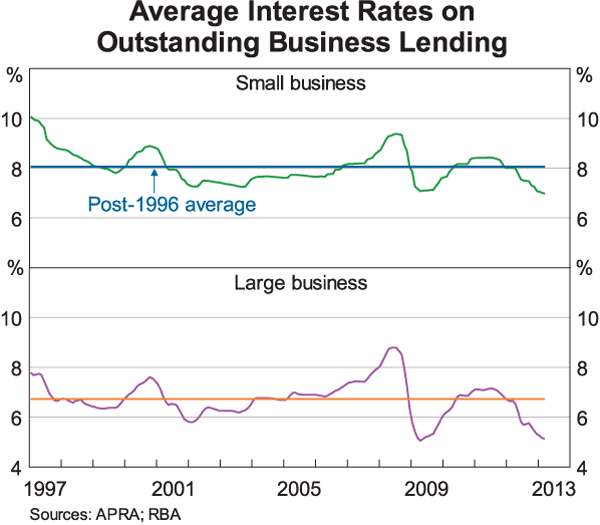
Meanwhile, businesses have access to internal funding, with non-mining profits (as a share of GDP) not much below the average of the past 15 years or so. In short, businesses overall have access to funding, both external and internal, on reasonably favourable terms. That's not true for all businesses, and we are aware that some businesses have found that loans are more difficult to come by or only on less favourable terms than they had been used to prior to the financial crisis. However, some tightening in the availability of credit since that period is to be expected and reflects more prudent behaviour by lending institutions.
While the high level of the exchange rate is weighing on trade exposed industries – particularly those not benefiting from the high prices of commodities – it also helps to keep down the cost of imported capital. This will benefit firms investing in machinery and equipment, which constitutes a large share of non-mining business investment.
Non-residential building activity remains relatively subdued, but prospects are that investment in building and structures outside of the resources sector will pick up gradually. The current growth of the population – at around 1.7 per cent annually – will provide some support for demand. Not only does population growth add to the demand for new goods and services, it also gradually eats into any existing spare capacity that might be hanging over some industries and provides an impetus for investment in new capacity.
While non-mining business investment is relatively low as a share of nominal GDP, it has been growing in real terms over the past two years (Graph 6).[8] The profile of real non-mining business investment since late 2011, when the Bank started cutting interest rates, lies somewhere in between the profile of investment during other episodes of declining interest rates (Graph 7). So far during the current episode, the growth of non-mining business investment has been less than it was during the early 2000s and mid 1990s, but more than it was during the financial crisis and the early 1990s recession. Our forecasts in the February SMP embodied moderate growth in non-mining business investment, which would, if it comes to pass, place the current episode in between these four earlier episodes.
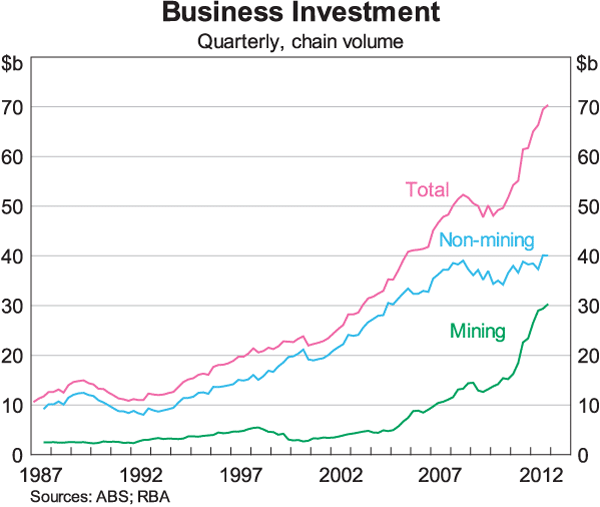

Perhaps the key piece of news for non-mining investment received since February has been the ABS Capital Expenditure Survey. This provides an estimate of firms' investment plans for the rest of this financial year and the first reading for 2013/14. Overall, what firms have told the ABS is consistent with non-mining business investment remaining subdued this financial year but then gradually picking up over the next.
To conclude, our expectation is that there will be a gradual recovery in non-mining business investment and further moderate growth of dwelling investment. While many of the drivers of investment support such an outlook, and low interest rates are playing their role, the profile for non-mining business investment remains uncertain, including because of the high level of the exchange rate. The profile for mining investment also remains uncertain, though it appears that the peak in mining investment is likely to occur this year. Pulling all of this together suggests that growth for the economy as a whole will be a little below trend this year and then pick up gradually through next year.
Endnotes
See Lowe P (2013), ‘Internal Balance, Structural Change and Monetary Policy’, Address to the Australian Industry Group 13th Annual Economics Forum, 19 March, and Plumb M, C Kent and J Bishop (2013), ‘Implications for the Australian Economy of Strong Growth in Asia’, RBA Research Discussion Paper 2013-03. [1]
See Kent C (2013), ‘Recent Developments in the Australian Housing Market’, 14 March. [2]
The extent of this uncertainty for GDP is illustrated in Tulip P and S Wallace (2012), ‘Estimates of Uncertainty around the RBA's Forecasts’ RBA Research Discussion Paper 2012-07 and Reserve Bank of Australia (2013), Statement on Monetary Policy, February. [3]
For evidence of this, see Bishop J, T Gill and D Lancaster (2013), ‘GDP Revisions: Measurement and Implications’, RBA Bulletin, March, pp 11–22. [4]
The early releases of the capital expenditure surveys tend to be a somewhat more reliable guide for non-mining business investment than for mining investment; for details, see Cassidy N, E Doherty and T Gill (2012), ‘Forecasting Business Investment Using the Capital Expenditure Survey’, RBA Bulletin, September, pp 1–10. [5]
The Bry-Boschan quarterly algorithm can be used to identify cycles in dwelling investment, household consumption and business investment. The trough in the latter typically occurs after that of the other two expenditure components. [6]
For evidence on this latter point, see La Cava G (2005), ‘Financial Constraints, the User Cost of Capital and Corporate Investment in Australia’, RBA Research Discussion Paper 2005-12. [7]
The relatively low level of non-mining business investment as a share of nominal GDP reflects, in part, the effect of the still high terms of trade on nominal incomes. [8]